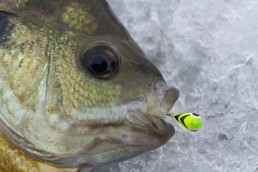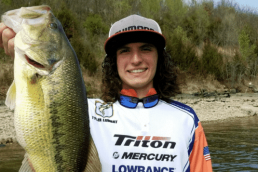Ice Tricks: Stone-cold Advice from the Hardwater Tournament Trail
SHARE THIS POST
So maybe attending a weigh-in at the North American Ice Fishing Circuit (NAIFC) Championship is a little less exciting than sitting in the stands at the Bassmaster Classic—ice anglers are bundled up inside cavernous parkas, donning big boots and carrying their 5-gallon buckets while the Bass-heads are sporting flashy jerseys slathered with logos and clutch flippin’ sticks while standing on the casting decks of expensive, flashy boats.
Beyond the obvious fact that one group fishes through snow and ice while the other casts to clear-blue waters, the two pursuits are almost identical, right?
The truth is, despite a little lack of recognition, anglers who compete on the NAIFC tour might surprise you. These are highly skilled anglers who know their stuff. These ice anglers are so good that at each tournament stop they regularly fish circles around the best local talent. But take the time to chat with any of these folks who fish this annual ice circuit and you’ll surely walk away with some powerful fish-finding and catching advice.
Just as in the big world of pro bassin’, competition on the ice inspires ingenuity, innovation and brilliant, new gear that ultimately benefits the everyday angler.
Underwater investigation
Among the most interesting outcomes at ice events is the discovery of new spots on lakes that receive regular fishing pressure from the local anglers. Wherever tourney anglers travel—venues at Hebgen Lake in Montana to Lake Maxinkuckee in Indiana—the competitors inevitably uncover fresh schools of biting panfish.
“When we arrive at a new lake, our number one priority is to find fish that haven’t seen lures in a while,” says Brandon Newby, who, along with partner, Ryan Wilson, captured three consecutive NAIFC Team of the Year titles beginning in 2013. “It’s not unusual for us to drill 600 to 800 holes during pre-fishing. At Mitchell Lake (in) South Dakota last year, we drilled and scouted with our Micro cameras until we finally found an underwater tree that held some bigger ‘gills and crappies.”
Newby said there are many years where they don’t wet their lines before a tournament, opting to remain discreet.
“It’s a stealth thing,” he said, referring to the hoards of followers and fellow competitors who know all about the team’s fish-finding abilities. “Our Milwaukee M28 lets us travel light; as do our Aqua-Vu Micro cameras, which fit into our coat pockets.
Last year, Newby and Wilson helped design a new Micro Mobile Pro Vu Case with Aqua-Vu, which allowed them to actually wear their camera around our necks, providing a huge time-saver without giving away strategy.
“Often, it’s not enough to find fish. The trick is to keep our spots secret until game time.”
It sounds slightly like paranoia until you consider the virtual targets painted on their backs, a result of winning so frequently.
“Last year at Croton Dam Pond (in) Michigan, we had the tournament-winning location entirely to ourselves,” Newby says. “When we arrived this year, 100 people were already in our spot. It forced us to look to alternative locations into deeper water, where after drilling for two days, we finally found another untouched school of nice bluegills.”
Two weeks before walking away with their second straight win at Croton Dam, Newby and Wilson notched a victory at Mitchell Lake thanks to some stealthy camera work and careful study before the tourney.
“We like to record what we find on the Micro Plus with DVR. At Mitchell, we went back to our hotel rooms and studied the footage on our laptops, determining that the fish we found were the right ones—bigger than any of the stunted crappies and smaller sunfish we’d spotted in any of the other 400 holes,” Newby says, laughing.
He added that the other advantage to their mini-cameras was the built-in depth and water temperature functions.
Are you enjoying this post?
You can be among the first to get the latest info on where to go, what to use and how to use it!
“You can’t believe how often finding slightly warmer water—say 37 or 38 degrees surrounded by 36—can be the difference that holds fish. Sometimes, we even fish warm-water pockets in specific depth ranges. Those are just some of the details that lead us to bigger panfish.”
‘Spring’ in to action
While Newby and Wilson excel at locating untouched pockets of big fish, tournament colleagues, Kevin Fassbind, Nick Smyers and Shawn Bjonfald, often dominate the “presentation” department.
Bjonfald, the group’s “spiritual” leader of sorts, divulges details on rigging the right rod whether he’s wielding a palm rod, Frabill Black Ops or a St. Croix Legend Gold, and is adamant about the use of a “spring”—street slang for a spring-tipped strike indicator.
“It’s not enough to simply slap a spring on the end of your rod and start jigging,” he says, “especially when you can really up your game with minor, easy adjustments.”
Plastics, for example, call for a different spring strategy than live bait.
“When fishing tiny plastics, you need more precision, more control of jig movement. I can simply slide the St. Croix spring in or out, extending it farther for a softer, less precise presentation, or, push it back for a little extra control. For plastics, I adjust the spring until it hangs at 25 to 30 degrees under the load of the jig (in water). For live bait, I prefer a softer spring and a 45-degree angle.”
Bjonfald added that the spring isn’t just about bite detection, but it’s also about jig presentation.
Meanwhile, Fassbind and Smyers stay on point with presentation, always working new ways to induce bites amid intense fishing pressure. For fine-tuned, panfish “dentistry,” both anglers wield long rods and tungsten Majmun jigs—an innovative Custom Jigs & Spins ball-headed bait that presents micro-soft baits at specific, critical angles.
Fixtures atop the leaderboards at tournaments, fellow competitors know all too well this team’s talent for icing weed beds full of panfish.
One key has been their jig combo itself—dressing their Majmun with hand-cut slivers of Uncle Josh Meat, which is essentially a jig and micro-slice of pork rind. The Majmun punches through slush ice and dense cover quickly. The jig can also ride with the hook tipped just below “horizontal,” an awesome assist for consistently successful hook-sets. The ultra-soft Meat slivers convert selective sniffers into fish that entirely engulf and hold.
If the bite really erodes or if the anglers find themselves surrounded by dozens of other anglers all vying for the same school of fish, they’ll often dig even deeper into their bag of tricks. Adding a soft bait “collar” to the jig, such as Nuclear Ant Legs, provides secondary movement to the jig, a move that keeps the lure’s tentacles quivering, even at rest.
These tournament teams keep plenty of other tricks under their fishing hats, but at least for now, they’ll have to wait until the next big win.
“It’s amazing to step back and see how fast this sport is growing,” Newby says. “In a few short years, competition has increased tenfold.”
They know everyone has cameras now, which is a key tool for finding the fish.
“It’s really revolutionized tournament ice fishing. But we can’t give up all our secrets. Ryan and I are working with a new technology right now that could blow the lid off the whole works by the time first ice forms.”
MWO
SHARE THIS POST
Did you enjoy this post?
You can be among the first to get the latest info on where to go, what to use and how to use it!
Ted Pilgrim
MidWest Outdoors works with more than 200 outdoor experts each year, who contribute articles based on their areas of expertise. MidWest Outdoors magazine offers more fishing and hunting articles than any other publication!






